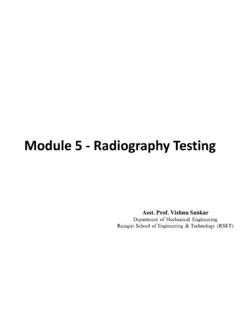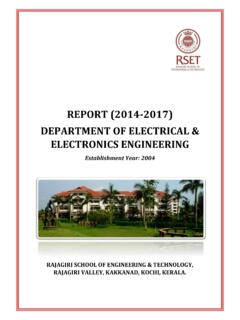Transcription of BASICS OF HEAT TRANSFER - Rajagiri School of Engineering ...
1 ME 302 EXPECTED [3] [4] [5] ,BoilingandCondensation[3] [4] ,chemicalreaction,andconvection[3]Basic concepts Heatistheformofenergythatcanbetransferre dfromonesystemtoanotherduetoatemperature differenceorgradient. Thesciencewhichdealswiththeratesofsuchen ergytransferisknownas heattransfer . Heatisavectorquantity,f lowinginthedirectionofdecreasingtemp, (howlong). , of Heat TRANSFER There are basically three Conductionrefertothethermalenergytransfe rthatwilloccuracrossamedium,whichmaybeas olidoraf luidduetoatemperaturedifference. Convectionrefertothethermalenergytransfe rbetweenasurfaceandamovingf luidwhentheyareatdifferenttemperaturelev els. Thermalradiationrefertothenettransferoft hermalenergybetweentwosurfacesatdifferen ttemperaturelevels, mechanisms for different modes of HTCONDUCTION Thermalconductionisthetransferofthermale nergyfromthehighenergetictothelowenerget icparticlesofastationarymedium(solids,li quidsorgas)duetointeractionsbetweenthepa rticles.
2 Insolids,conductionmaybeattributedtoatom icactivityintheformoflatticevibrationsan denergytransportbythefreeelectrons. Inf luids,conductionoccursduetothecollisions anddiffusionofthemoleculesduringtheirran dommotion. Itisamicroscopicformofheattransfer. Thebasicequationforthermalconductionisth eFourier slaw. Itstatesthattheheatf lux(HeatTransferrateperunitarea) dT/dxorq -kdT/dx Where,k-thermalconductivity( )dT/dx-temperaturegradientq-heatf lux( ) = Assumptions of Fourier s Conductivity(k) Itisthemeasureoftheabilityofamaterialtoc onductheat. Itisoneofthetransportpropertiesofamateri al. ItsunitisW/m0 ForSolidsandLiquids,k=f(T) Forgases/vapor,k=f(p,T) Metalsarebestconductors.
3 Alloyingofmetalswillreduce k k decreaseswithincreaseintempinmostofmetal sexceptAluminumandUranium. InAluminum. k isconstantbetween-1300 Cto3700C InUraniumitisincreaseswithtemp. Gaseswithhighmolecularweighthavesmall k . Materialshavingcrystallinestructurehaveh igh k thanamorphousform. Formostmaterialsk=k0(1+ t)Wherek0isthermalconductivityat00C isaconstant(+veor ve)CONVECTION Convectionrefertothethermalenergytransfe rbetweenasolidsurfaceandamovingf luidwhentheyareatdifferenttemperaturelev els. Itinvolvesthecombinedeffectofconductiona ndfluidmotion. Heatistransferfromthesolidsurfacetothef luidlayerwhichisincontactwithitbyconduct ion. Thentotheadjacentlayersheatwilltransferb ytherandommolecularmotion.
4 Duetothef luid-surfaceinteraction,ahydrodynamicbou ndarylayerisdevelopedwithzerovelocityatt hewallandafinitevelocitylevelatthebounda ry. Sincethefreestreamtemperatureofthef luidandthetemperatureatthewallarediffere nt,athermalboundarylayerwillalsobedevelo pedasshownabove. (Free) Forcedconvectionisthetransferofthermalen ergywhenthef lowiscausedbyexternalmeans,suchasafan,ap umporatmosphericwinds. Naturalconvectionisinducedbybuoyancyforc esduetodensityvariationsasaresultoftempe raturedifferences. Boilingandcondensationareexamplesforsuch processes. Thebasicequationforconvectionheattransfe risknownasNewton slawofcooling: = ( )Where, isthesurfacetemperature, isthef ( 2 ) hisalsocalledfilmheattransfercoefficient orsurfaceconductance.
5 Thevalueof h :plate,cylinderorsphere, luid:density,viscosity,specificheat, Thermalenergytransferbyradiationiscaused byelectromagneticwaves(orphotons). Thermalradiationisemittedbyallsurfaceswh icharekeptatafinitetemperaturelevel. Thishappensfromsolids,liquidsandgases. Radiantenergydoesnotrequireamaterialmedi umforitstransport. Moreover,radiationtransferwilloccureffec tivelyinvacuum. The mechanism of heat f low by radiation consists three distinct of thermal energy of the hot source into electromagnetic waves. Photons are propagated through the space as of wave motion through intervening space Photons travel with unchanged frequency in straight paths with speed equal to that of of waves into heat.
6 Reconversion of wave motion into energy occurs in the receiving surface which may partly absorbed, ref lected or transmitted through. The basic rate equation for radiation HT is the Stefan-Boltzmanlaw: = Where, is the energy radiated per unit is the absolute temp of the surface is the Stefan-Boltzmanconstant = 10 8 / 2 4 CARTESIAN COORDINATESCYLINDRICALSPHERICAL









